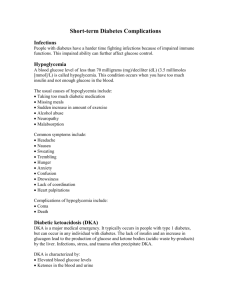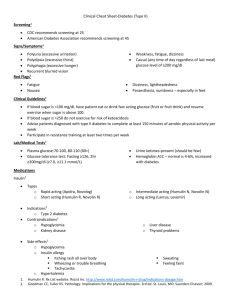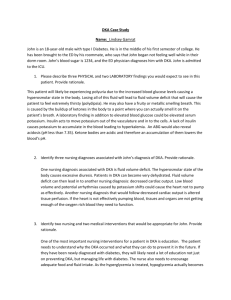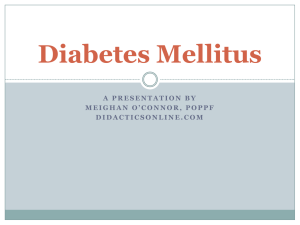Manifestations of Diabetic Ketoacidosis
advertisement
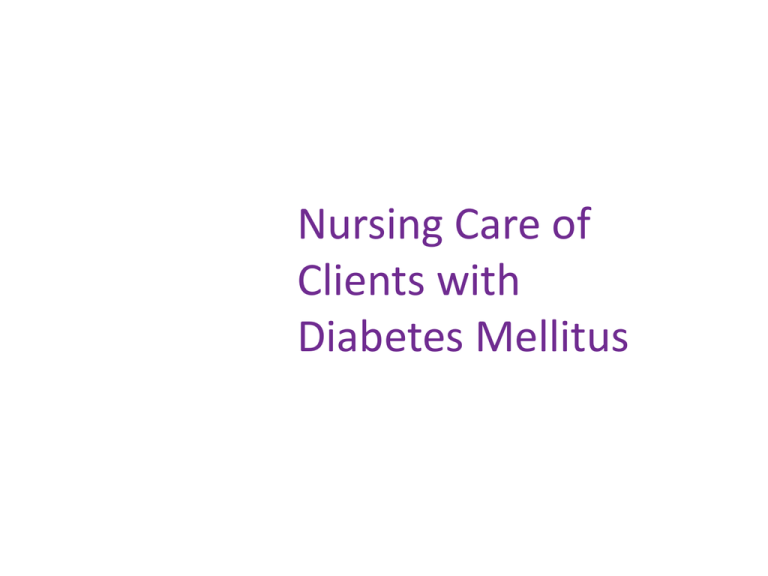
Nursing Care of Clients with Diabetes Mellitus Nursing Care for DM • Clients face lifelong changes in lifestyle and health status • Major role of the nurse is that of educator in both hospital and community settings • Plan of care and content differ according to the type of diabetes • Nursing care focuses on teaching to manage the illness Type 1 and Type 2 Diabetes • Type 1 – Occurs in childhood/ adolescence – Genetic predisposition – Hyperglycemia – Polyuria, polyphagia, glucosuria, polydipsia Type 1 and Type 2 Diabetes Type 1 and Type 2 Diabetes Type 1 and Type 2 Diabetes Type 1 and Type 2 Diabetes Type 1 and Type 2 Diabetes Type 1 and Type 2 Diabetes Type 1 and Type 2 Diabetes Type 1 and Type 2 Diabetes • Type 2 – Occurs at any age – Heredity plays a role – Slow onset – Symptoms not as severe as type 1 Complications • Manifestations of Diabetic Ketoacidosis – Dehydration (from hyperglycemia) • • • • • • • • Thirst Weakness Warm, dry skin with poor turgor Malaise Soft eyeballs Rapid, weak pulse Dry mucous membranes Hypotension Complications – Metabolic acidosis (from ketosis) • • • • Nausea and vomiting Lethargy Ketone (fruity, alcohol-like) breath odor Coma – Other manifestations • Abdominal pain (cause unknown) • Kussmaul’s respirations (increased rate and depth of respirations, with a longer expiration; a compensatory response to prevent a further decrease in pH) Complications – Manifestations of hyperosmolar hyperglycemic state (HHS) • Occurs in clients who have type 2 diabetes and is characterized by a plasma osmolarity of 340 mOsm/L or greater, and blood glucose levels of over 600 mg/dl, which causes altered levels of consciousness Complications – Manifestations of hypoglycemia caused by responses of the autonomic nervous system • • • • • • • • • Hunger Shakiness Nausea Irritability Anxiety Rapid pulse Pale, cool skin Hypotension Sweating Complications – Manifestations caused by impaired cerebral function • • • • • • • • • • Strange or unusual feelings Slurred speech Blurred vision Headache Decreasing levels of consciousness Difficulty in thinking Inability to concentrate Seizures Change in emotional behavior Coma Complications – Interdisciplinary Care • Maintaining blood glucose • Definitions of normal blood glucose levels vary in clinical practice, depending on the laboratory that performs the assay • Pharmacologic treatment for diabetes mellitus depends on the type of diabetes • Dietary management for adults with diabetes, based on guidelines established by the ADA. • The ability to maintain an exercise program is affected by many different factors DKA, HHS, and Hypoglycemia Compared DKA, HHS, and Hypoglycemia Compared DKA, HHS, and Hypoglycemia Compared DM Screening and Monitoring Tests • DM Screening Tests – Casual plasma glucose (PG): (>200 mg/dL) any time of day without regard to time since the last meal – Fasting plasma glucose (FPG): (> 126 mg/dL) no caloric intake in 8 hours – Two-hour PG: (>200mg/dL) during an oral glucose tolerance test DM Screening and Monitoring Tests • Management of Diabetes – Fasting blood glucose (FBG): normal range 70-110 mg/dL – Glycosylated hemoglobin: used to determine the average glucose level over 2–3 months, values above 7%–9% considered elevated – Urine glucose and ketone levels: not as accurate as monitoring changes in blood glucose levels DM Screening and Monitoring Tests – Urine test: indicates presence of protein as albumin – Serum cholesterol and triglyceride levels: indicators of arthrosclerosis and increased cardiovascular impairment – Serum electrolytes: measure in clients who have DKA or HHS to determine imbalances Insulin and Oral Hypoglycemic Agents • Insulin – Monitor storage and expiration of insulin – Monitor and maintain a record of blood glucose readings as prescribed – Monitor food intake • Oral Hypoglycemics – – – – Administer with food Assess diet and exercise Monitor for hypoglycemia and hyperglycemia Assess for side effects Self-Management of DM • Maintain prescribed diet and exercise • Insulin needs are increased if you have surgery, trauma, fever, or infection • Monitor blood glucose • Report any illness or side effects to healthcare provider • Undergo periodic lab evaluations • Avoid alcohol intake • Take medications as prescribed • Some medications (oral) may interfere with oral contraceptives Nursing Process Framework • • • • • • • Health promotion Assessment Risk for impaired skin integrity Risk for infection Risk for injury Sexual dysfunction Ineffective coping
